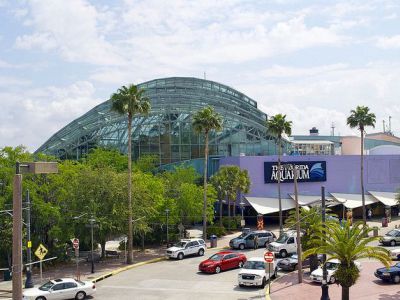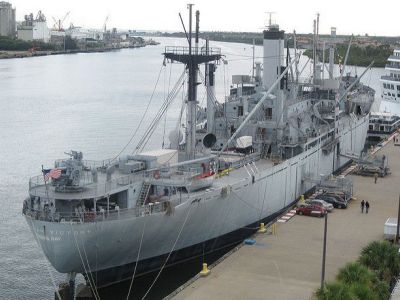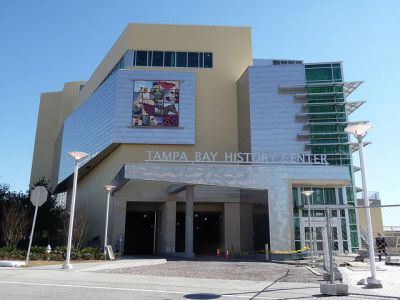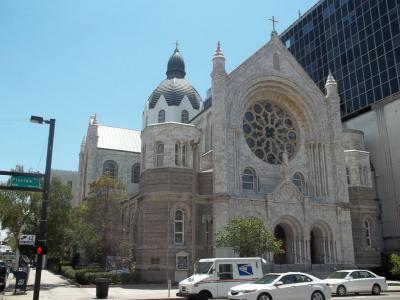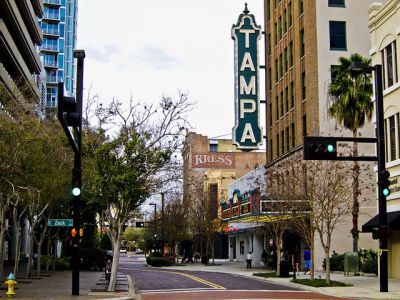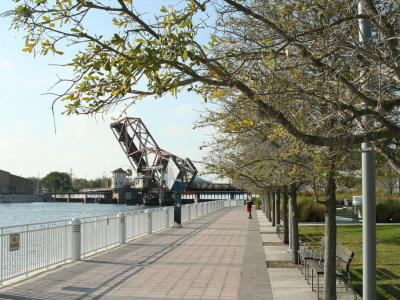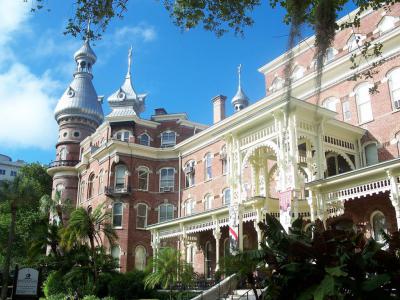Audio Guide: Tampa Downtown Walking Tour (Self Guided), Tampa
Tampa’s story begins long before skyscrapers and cruise ships lined its shores. Thousands of years ago, the Tocobaga and other Indigenous peoples lived along Tampa Bay, thriving on the abundance of fish and shellfish from its shimmering waters. By the time Spanish explorers like Juan Ponce de León first sailed into the area in the early 1500s, this coast was already home to well-established cultures that needed no introduction to paradise. The Spanish, however, didn’t linger; the swamps and mosquitoes weren’t quite their dreamland.
Fast-forward to 1824, when the U.S. Army built Fort Brooke at the mouth of the Hillsborough River, setting in motion Tampa’s transformation from a remote outpost into a permanent settlement. A few decades later, the little "Village of Tampa" was officially incorporated, though its early years weren’t exactly smooth sailing. Epidemics, isolation, and the occasional Seminole conflict made progress a slow affair – but perseverance runs deep here.
Everything changed when Henry B. Plant’s railroad arrived in 1884, connecting Tampa to the rest of Florida and the world beyond. With it came industry, trade, and a colorful mix of new residents. One of them, Cuban entrepreneur Vicente Martínez Ybor, brought his cigar business north from Key West and established Ybor City – a move that would shape Tampa’s soul. Soon, the rhythmic clatter of cigar rollers filled the air, blending with the aroma of rich tobacco and the lively chatter of Cuban, Spanish, and Italian immigrants who turned this once-quiet town into a bustling "Cigar City."
By the turn of the 20th century, Tampa was booming. Its port grew busy with ships carrying cigars, phosphate, and dreams of prosperity. The city’s Latin neighborhoods thrived, jazz bands played in open courtyards, and the clinking of glasses echoed through cantinas. Over the years, Tampa’s character expanded along with its skyline – from cigar smoke to commerce, from speakeasies to skyscrapers, from the hum of factories to the buzz of festivals.
Today, Tampa is a fascinating mix of old and new – where historic brick streets lead to sparkling glass towers, and century-old cigar shops share blocks with trendy cafés. The waterfront has been reborn with parks and cultural landmarks, while the port remains one of Florida’s busiest gateways. And for those who want to truly walk through this story rather than just read about it, a self-guided walking tour is the perfect way to uncover Tampa’s layers – step by step, past the echoes of cigar rollers and the scent of Cuban coffee that still lingers in the air.
Fast-forward to 1824, when the U.S. Army built Fort Brooke at the mouth of the Hillsborough River, setting in motion Tampa’s transformation from a remote outpost into a permanent settlement. A few decades later, the little "Village of Tampa" was officially incorporated, though its early years weren’t exactly smooth sailing. Epidemics, isolation, and the occasional Seminole conflict made progress a slow affair – but perseverance runs deep here.
Everything changed when Henry B. Plant’s railroad arrived in 1884, connecting Tampa to the rest of Florida and the world beyond. With it came industry, trade, and a colorful mix of new residents. One of them, Cuban entrepreneur Vicente Martínez Ybor, brought his cigar business north from Key West and established Ybor City – a move that would shape Tampa’s soul. Soon, the rhythmic clatter of cigar rollers filled the air, blending with the aroma of rich tobacco and the lively chatter of Cuban, Spanish, and Italian immigrants who turned this once-quiet town into a bustling "Cigar City."
By the turn of the 20th century, Tampa was booming. Its port grew busy with ships carrying cigars, phosphate, and dreams of prosperity. The city’s Latin neighborhoods thrived, jazz bands played in open courtyards, and the clinking of glasses echoed through cantinas. Over the years, Tampa’s character expanded along with its skyline – from cigar smoke to commerce, from speakeasies to skyscrapers, from the hum of factories to the buzz of festivals.
Today, Tampa is a fascinating mix of old and new – where historic brick streets lead to sparkling glass towers, and century-old cigar shops share blocks with trendy cafés. The waterfront has been reborn with parks and cultural landmarks, while the port remains one of Florida’s busiest gateways. And for those who want to truly walk through this story rather than just read about it, a self-guided walking tour is the perfect way to uncover Tampa’s layers – step by step, past the echoes of cigar rollers and the scent of Cuban coffee that still lingers in the air.
How it works: Download the app "GPSmyCity: Walks in 1K+ Cities" from Apple App Store or Google Play Store to your mobile phone or tablet. The app turns your mobile device into a personal tour guide and its built-in GPS navigation functions guide you from one tour stop to next. The app works offline, so no data plan is needed when traveling abroad.
Tampa Downtown Walking Tour Map
Guide Name: Tampa Downtown Walking Tour
Guide Location: USA » Tampa (See other walking tours in Tampa)
Guide Type: Self-guided Walking Tour (Sightseeing)
# of Attractions: 7
Tour Duration: 2 Hour(s)
Travel Distance: 3.2 Km or 2 Miles
Author: anna
Sight(s) Featured in This Guide:
Guide Location: USA » Tampa (See other walking tours in Tampa)
Guide Type: Self-guided Walking Tour (Sightseeing)
# of Attractions: 7
Tour Duration: 2 Hour(s)
Travel Distance: 3.2 Km or 2 Miles
Author: anna
Sight(s) Featured in This Guide:
- Florida Aquarium
- SS American Victory Mariners' Memorial and Museum Ship
- Tampa Bay History Center
- Sacred Heart Church
- Tampa Theatre
- Tampa Riverwalk
- Henry B. Plant Museum
1) Florida Aquarium (must see)
If you visit Tampa and skip The Florida Aquarium, you’re missing one of the city’s most delightful contradictions: a tranquil sea-world tucked right into the downtown bustle. Here’s why it’s a must-see – and yes, you can still feel like a kid watching fish swirl around your feet.
Since its launch on March 31 1995, the Aquarium has been doing more than just stacking tanks: in 2025 it proudly celebrated its 30th anniversary, having welcomed over 20 million guests and educated nearly 2 million children through on-site programmes.
What that means is: whether you’re a family with small kids, a solo traveller or a lover of marine life with a penchant for witty captions, this place has something for you.
The space is thoughtfully engineered: expect immersive zones, touch-tank encounters where you can gently stroke rays and starfish, and exhibition halls that don’t just show animals but also tell their stories. For example, the Aquarium recently unveiled a brand-new Pacific Northwest-style tide-pool exhibit: 4,000 gallons of crisp, 50°F water, more than 200 invertebrates, and a 60-foot stretch of interactive fun – yes, nature and "wow" coexisting happily.
At the same time, the venue is serious about its conservation game – coral-reef regeneration, rescued sea turtles, and educational outreach are part of the package.
Visiting tips: Arrive early, especially if you haven’t booked timed tickets – peak hours fill quickly. If you want to avoid crowds, the late afternoon can be calmer, and you might catch an animal-feeding moment or behind-the-scenes peek. Bonus: since it’s located downtown, you can combine your visit with a stroll along the waterfront or a coffee break in one of the nearby districts.
In short: this isn’t just "an aquarium" – it’s a lively, evolving experience that blends fun, education and awe. For anyone touring Tampa, it’s not optional; it’s essential.
Since its launch on March 31 1995, the Aquarium has been doing more than just stacking tanks: in 2025 it proudly celebrated its 30th anniversary, having welcomed over 20 million guests and educated nearly 2 million children through on-site programmes.
What that means is: whether you’re a family with small kids, a solo traveller or a lover of marine life with a penchant for witty captions, this place has something for you.
The space is thoughtfully engineered: expect immersive zones, touch-tank encounters where you can gently stroke rays and starfish, and exhibition halls that don’t just show animals but also tell their stories. For example, the Aquarium recently unveiled a brand-new Pacific Northwest-style tide-pool exhibit: 4,000 gallons of crisp, 50°F water, more than 200 invertebrates, and a 60-foot stretch of interactive fun – yes, nature and "wow" coexisting happily.
At the same time, the venue is serious about its conservation game – coral-reef regeneration, rescued sea turtles, and educational outreach are part of the package.
Visiting tips: Arrive early, especially if you haven’t booked timed tickets – peak hours fill quickly. If you want to avoid crowds, the late afternoon can be calmer, and you might catch an animal-feeding moment or behind-the-scenes peek. Bonus: since it’s located downtown, you can combine your visit with a stroll along the waterfront or a coffee break in one of the nearby districts.
In short: this isn’t just "an aquarium" – it’s a lively, evolving experience that blends fun, education and awe. For anyone touring Tampa, it’s not optional; it’s essential.
2) SS American Victory Mariners' Memorial and Museum Ship
Step aboard the SS American Victory in downtown Tampa and you’ll find yourself immersed in living history – without needing a time machine. This 1945-built "Victory" class cargo ship served in World War II, the Korean War and the Vietnam War before being rescued from scrap and transformed into a museum ship in 1999.
Today, it remains one of only three operational Victory-class ships in the United States that visitors can still explore. A self-guided tour takes you across nine decks, from the cargo holds and crew cabins to the engine room and gun turrets, offering a vivid glimpse into how 1940s sailors lived and worked at sea. The ship is docked in the vibrant Channelside District, right behind The Florida Aquarium, making it easy to combine both attractions into a single outing.
Practical tips: wear sturdy shoes, as the ship’s steep ladders and metal stairs can be challenging, and bring water—some enclosed areas can get warm in Florida’s subtropical climate.
In short: the SS American Victory is a hands-on piece of maritime heritage – expect to climb, explore and imagine convoys in wartime seas. If you’re visiting Tampa and want something off the usual tourist track yet deeply rooted in story and substance, this is it.
Today, it remains one of only three operational Victory-class ships in the United States that visitors can still explore. A self-guided tour takes you across nine decks, from the cargo holds and crew cabins to the engine room and gun turrets, offering a vivid glimpse into how 1940s sailors lived and worked at sea. The ship is docked in the vibrant Channelside District, right behind The Florida Aquarium, making it easy to combine both attractions into a single outing.
Practical tips: wear sturdy shoes, as the ship’s steep ladders and metal stairs can be challenging, and bring water—some enclosed areas can get warm in Florida’s subtropical climate.
In short: the SS American Victory is a hands-on piece of maritime heritage – expect to climb, explore and imagine convoys in wartime seas. If you’re visiting Tampa and want something off the usual tourist track yet deeply rooted in story and substance, this is it.
3) Tampa Bay History Center
The Tampa Bay History Center rests gracefully along Tampa’s Riverwalk at 801 Water Street, offering an intriguing detour from the usual tourist circuit. As you step inside this three-floor institution, you’ll find yourself immersed in 12,000 years of Florida’s past – from the first Indigenous communities to Spanish conquistadors, cigar-rolling immigrants and all the shifting tides that shaped the region.
The exhibits are well-crafted and refreshingly interactive, showcasing everything from maritime trade routes and pirate legends to detailed maps and personal stories of the people who shaped the bay. Meanwhile, its permanent collections – like the Touchton Map Library with its thousands of maps spanning centuries – remain a rich repository of local and cartographic heritage.
The layout is visitor-friendly: galleries flow from ancient landscapes into colonial climes, then onto industrial growth and community-changing eras. The adjacent Columbia Café serves up Cuban/Spanish-inspired dishes, so you can ease into history over lunch without leaving the complex.
While the Tampa Bay History Center might not leap out as a must-see for every traveller, it rewards anyone with even a modest interest in the deeper layers of Tampa’s story. If time allows, it’s a smart way to add meaningful context to your visit – pausing, for an hour or two, from the bustle of beaches and nightlife, and recognising how the present was shaped by centuries of people, trade and change.
The exhibits are well-crafted and refreshingly interactive, showcasing everything from maritime trade routes and pirate legends to detailed maps and personal stories of the people who shaped the bay. Meanwhile, its permanent collections – like the Touchton Map Library with its thousands of maps spanning centuries – remain a rich repository of local and cartographic heritage.
The layout is visitor-friendly: galleries flow from ancient landscapes into colonial climes, then onto industrial growth and community-changing eras. The adjacent Columbia Café serves up Cuban/Spanish-inspired dishes, so you can ease into history over lunch without leaving the complex.
While the Tampa Bay History Center might not leap out as a must-see for every traveller, it rewards anyone with even a modest interest in the deeper layers of Tampa’s story. If time allows, it’s a smart way to add meaningful context to your visit – pausing, for an hour or two, from the bustle of beaches and nightlife, and recognising how the present was shaped by centuries of people, trade and change.
4) Sacred Heart Church
In the midst of downtown Tampa, the Sacred Heart Church quietly stands as a testament to history weaving into modern city life. Built between 1898 and 1905 under the direction of architect Nicholas J. Clayton, the Romanesque-style structure with its granite and white marble façade captures your attention before you even step inside.
Originally founded as St. Louis Parish in 1859, the church evolved alongside Tampa itself – through yellow-fever epidemics, the arrival of the railroad, and waves of immigrants who transformed the city’s character. The current building was dedicated on January 15 1905, when the name changed to Sacred Heart Parish.
Inside, you’ll discover 70 stained-glass windows made in Munich that bathe the nave in a kaleidoscope of light. The soaring 135-foot dome and solid oak pews speak of the craftsmanship of a century ago, yet the church continues to welcome visitors and worshippers alike.
While you pause mid-walk between modern buildings and lively cafés, step inside the church, take a breath (silently if you wish), and soak in the sense of continuity. It offers a meaningful complement to the bustling city – an invitation to slow down and connect with Tampa’s deeper currents of faith, architecture and community.
Originally founded as St. Louis Parish in 1859, the church evolved alongside Tampa itself – through yellow-fever epidemics, the arrival of the railroad, and waves of immigrants who transformed the city’s character. The current building was dedicated on January 15 1905, when the name changed to Sacred Heart Parish.
Inside, you’ll discover 70 stained-glass windows made in Munich that bathe the nave in a kaleidoscope of light. The soaring 135-foot dome and solid oak pews speak of the craftsmanship of a century ago, yet the church continues to welcome visitors and worshippers alike.
While you pause mid-walk between modern buildings and lively cafés, step inside the church, take a breath (silently if you wish), and soak in the sense of continuity. It offers a meaningful complement to the bustling city – an invitation to slow down and connect with Tampa’s deeper currents of faith, architecture and community.
5) Tampa Theatre (must see)
Let’s step into the dazzling bygone era of movie-palaces with a visit to Tampa’s own grand jewel: the Tampa Theatre. Opened on October 15, 1926, this "atmospheric" masterpiece by architect John Eberson was designed to make you feel as if you’d wandered into a Mediterranean-courtyard under a starry sky – twinkling stars, gargoyles, tile roofs and all.
Back in its heyday, patrons paid a quarter to escape the Florida heat and sunk into plush seats beneath "man-made air". Fast-forward to 2025 and this majestic venue is still very much alive, playing host to hundreds of events each year – from first-run films and classic screenings, to live concerts, ghost tours (yes, it’s haunted), and behind-the-scenes architectural walks.
As you walk through its ornate lobby, you’ll feel the echoes of silent-film orchestras, the hush of a thousand excited audiences, and the glamour of an era when going to the movies meant something extravagant. Today, the majestic ceiling still seems to whisper: "You’re somewhere special." If you’re lucky, you’ll catch the restored 1,400-pipe Wurlitzer organ rising into song before the feature begins – a delightful reminder of the golden age.
For a visitor to Tampa looking for more than just another cinema experience, this theatre offers treasures for the eyes and the heart: ornate detail, living history, surprising spookiness – and a chance to sit and soak it in. Whether you come for the show or simply linger in the mezzanine and look up at those stars, the Tampa Theatre rewards curiosity. Don’t block out the evening yet – this place takes you somewhere magical.
Back in its heyday, patrons paid a quarter to escape the Florida heat and sunk into plush seats beneath "man-made air". Fast-forward to 2025 and this majestic venue is still very much alive, playing host to hundreds of events each year – from first-run films and classic screenings, to live concerts, ghost tours (yes, it’s haunted), and behind-the-scenes architectural walks.
As you walk through its ornate lobby, you’ll feel the echoes of silent-film orchestras, the hush of a thousand excited audiences, and the glamour of an era when going to the movies meant something extravagant. Today, the majestic ceiling still seems to whisper: "You’re somewhere special." If you’re lucky, you’ll catch the restored 1,400-pipe Wurlitzer organ rising into song before the feature begins – a delightful reminder of the golden age.
For a visitor to Tampa looking for more than just another cinema experience, this theatre offers treasures for the eyes and the heart: ornate detail, living history, surprising spookiness – and a chance to sit and soak it in. Whether you come for the show or simply linger in the mezzanine and look up at those stars, the Tampa Theatre rewards curiosity. Don’t block out the evening yet – this place takes you somewhere magical.
6) Tampa Riverwalk (must see)
Here’s the thing: strolling along the Tampa Riverwalk is like flipping through a glossy travel-magazine version of Tampa’s waterfront – except you’re actually walking it, and you might sneak in a Cuban sandwich or paddle past in a water taxi while you do. Spanning approximately 2.6 miles (4.2 km) along the scenic Hillsborough River from the Channelside District to Tampa Heights, this riverside promenade connects parks, museums, cafés and views in a way that even locals still find slightly magical.
Start your journey any time of day – early morning joggers share the bricks with dog-walkers, and by evening the LED lights under bridges flicker on to transform the path into a shimmering mirror of the city skyline.
Did you know? Parts of the Riverwalk are lit in special colours for events, so you might stroll through turquoise, purple or even sports-team gold depending on what’s happening in town.
Along the way you’ll pass by iconic spots like Curtis Hixon Waterfront Park, perfect for a lawn-lunch or art break, and the buzzing food and drink hub at Sparkman Wharf, where waterfront views and rooftop chill merge effortlessly. The surface is paved (brick, concrete, asphalt) and friendly to walkers, bikers, and even strollers and wheelchairs, making it a relaxing way to absorb Tampa’s energy without being trapped in a car.
This isn’t just a "nice view" spot – it’s a canvas of city life. Pause to watch a water taxi drift by, listen to laughter from a dog-friendly lawn, glimpse a street-musician playing near a museum façade, and let the Riverwalk show you how Tampa balances its river-front heritage with today’s urban buzz. If you’ve got a couple of hours free, allocate them here. You’ll head out thinking that downtown Tampa is far more than skyscrapers and traffic – it’s a waterfront rescued and rewoven into people’s day.
Start your journey any time of day – early morning joggers share the bricks with dog-walkers, and by evening the LED lights under bridges flicker on to transform the path into a shimmering mirror of the city skyline.
Did you know? Parts of the Riverwalk are lit in special colours for events, so you might stroll through turquoise, purple or even sports-team gold depending on what’s happening in town.
Along the way you’ll pass by iconic spots like Curtis Hixon Waterfront Park, perfect for a lawn-lunch or art break, and the buzzing food and drink hub at Sparkman Wharf, where waterfront views and rooftop chill merge effortlessly. The surface is paved (brick, concrete, asphalt) and friendly to walkers, bikers, and even strollers and wheelchairs, making it a relaxing way to absorb Tampa’s energy without being trapped in a car.
This isn’t just a "nice view" spot – it’s a canvas of city life. Pause to watch a water taxi drift by, listen to laughter from a dog-friendly lawn, glimpse a street-musician playing near a museum façade, and let the Riverwalk show you how Tampa balances its river-front heritage with today’s urban buzz. If you’ve got a couple of hours free, allocate them here. You’ll head out thinking that downtown Tampa is far more than skyscrapers and traffic – it’s a waterfront rescued and rewoven into people’s day.
7) Henry B. Plant Museum (must see)
Stepping into the Henry B. Plant Museum is like slipping into a time machine headed for the Gilded-Age boom of Florida – and yes, you’ll feel a little like you’ve wandered into a palace rather than a museum. Housed in the former Tampa Bay Hotel (constructed in 1888-1891) by railroad and steam-ship magnate Henry B. Plant, the building was designed in exotic Moorish-Revival style, complete with minarets, domes and shimmering interiors.
Back in its heyday as a resort from 1891 to 1932, the Tampa Bay Hotel was "Florida’s first Magic Kingdom": one of the very first hotels in Florida to boast electric lighting, telephones in guest rooms and an elevator. Plant’s vision was grand: build a winter palace for wealthy Northerners and tie it directly to his empire of railways and steamships.
The museum occupies part of the south wing of the former hotel, now known as Plant Hall and home to the University of Tampa. It still houses many of the original furnishings and artefacts collected by Plant and his wife during their travels in Europe and Asia, and uses a self-guided audio tour to bring the story to life.
The museum provides a tangible sense of Tampa’s transformation – from sleepy Gulf-coast town to stylish winter retreat to university campus. Enjoy the lavish textures, the dramatic architecture, and the way the building ties into the bigger story of how Tampa grew. Allow yourself to wander the grand public rooms, imagine the orchestras playing in the music-room, and the steamships arriving to drop off elite guests. It’s not the busiest attraction in town, but it rewards you with atmosphere, detail and a bit of show-manship. If you’ve got an hour or so in downtown Tampa and want to slow the pace while still soaking in a big slice of local heritage, the Henry B. Plant Museum is a strong choice.
Back in its heyday as a resort from 1891 to 1932, the Tampa Bay Hotel was "Florida’s first Magic Kingdom": one of the very first hotels in Florida to boast electric lighting, telephones in guest rooms and an elevator. Plant’s vision was grand: build a winter palace for wealthy Northerners and tie it directly to his empire of railways and steamships.
The museum occupies part of the south wing of the former hotel, now known as Plant Hall and home to the University of Tampa. It still houses many of the original furnishings and artefacts collected by Plant and his wife during their travels in Europe and Asia, and uses a self-guided audio tour to bring the story to life.
The museum provides a tangible sense of Tampa’s transformation – from sleepy Gulf-coast town to stylish winter retreat to university campus. Enjoy the lavish textures, the dramatic architecture, and the way the building ties into the bigger story of how Tampa grew. Allow yourself to wander the grand public rooms, imagine the orchestras playing in the music-room, and the steamships arriving to drop off elite guests. It’s not the busiest attraction in town, but it rewards you with atmosphere, detail and a bit of show-manship. If you’ve got an hour or so in downtown Tampa and want to slow the pace while still soaking in a big slice of local heritage, the Henry B. Plant Museum is a strong choice.
Walking Tours in Tampa, Florida
Create Your Own Walk in Tampa
Creating your own self-guided walk in Tampa is easy and fun. Choose the city attractions that you want to see and a walk route map will be created just for you. You can even set your hotel as the start point of the walk.
Ybor City Historic District Walking Tour
They say, where there’s smoke, there’s Ybor City... Indeed, this historic district, located just northeast of downtown Tampa, is a neighborhood where they've been rolling cigars for over a century. Its name comes from Vicente Martinez-Ybor, a Spanish cigar manufacturer who relocated his operations from Key West to Tampa in 1885, seeking better transportation access and a more favorable... view more
Tour Duration: 1 Hour(s)
Travel Distance: 2.1 Km or 1.3 Miles
Tour Duration: 1 Hour(s)
Travel Distance: 2.1 Km or 1.3 Miles
The Most Popular Cities
/ view all



